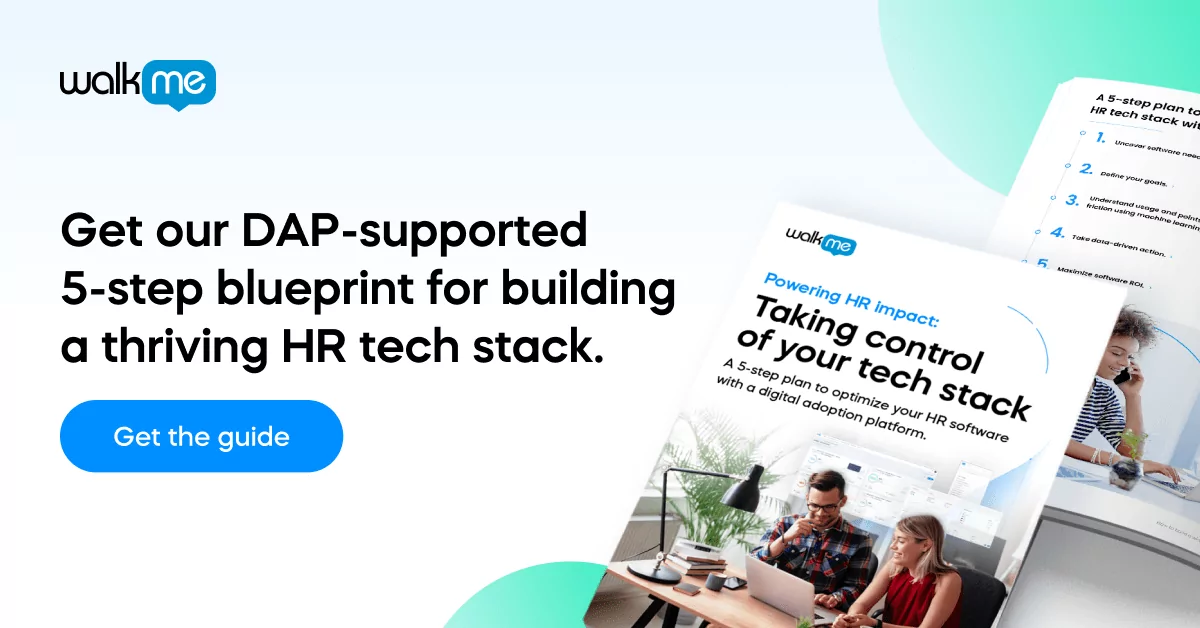When it comes to organizational essentials, an human resources compliance checklist is your first port of call. An HR compliance checklist (sometimes called an HR compliance audit) prevents many serious threats to your business and your staff and helps guide you through every step of compliance with HR policies so your staff and reputation are protected at all times.
To show you the essential aspects of the human resources compliance checklist, this article will cover this topic across the three stages of the employee lifecycle: interview, onboarding and onboarding, via the following topics:
- What is an HR compliance checklist?
- What is the job of an HR compliance checklist?
- The interview phase- before onboarding
- The onboarding phase
- After onboarding
First, let’s look at a definition of the HR compliance checklist.
What is an HR compliance checklist?
An HR compliance checklist is the checklist guiding your workplace policies and procedures to ensure they are in alignment with required laws and regulations as well as taking a proactive stance in maintaining such compliance. HR compliance is also an effective way to ensure efficient digital adoption of new technologies as part of digital employee experience management.
Human Resources must adhere to compliance regulations in order to create policies and procedures that ensure all laws, rules, and regulations are followed while also keeping the company’s goals at the forefront.
What is the job of an HR compliance checklist?
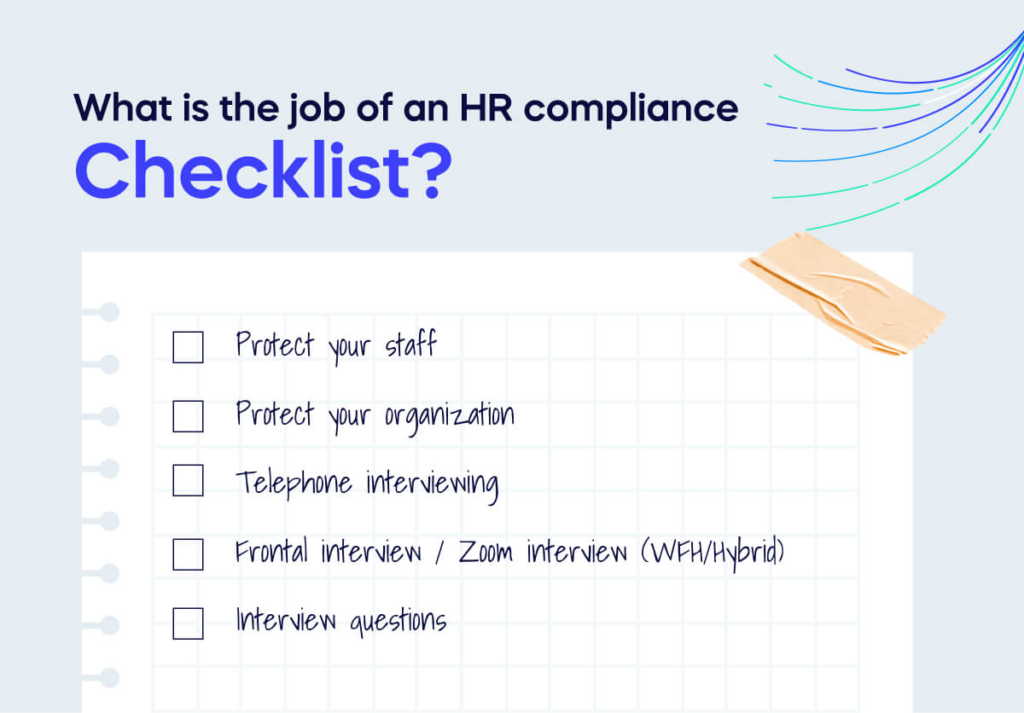
The Occupational Safety and Health Administration set fines for willful and repeat violations at $156,259 per violation in 2022. It is therefore helpful to know exactly what the job is of the HR compliance checklist so every department can be aware of the laws they must comply with to avoid these fines.
When your organization uses an HR compliance checklist, they are protecting both your organization and staff.
Protect your staff
There are many ways an HR compliance checklist protects your staff by adhering to every federal law, such as:
- Union compliance is protection offered by unions and seeks to ensure human rights are upheld by organizations.
- To ensure that the company implements best practices for its policies to protect staff by outlining acceptable behaviors.
- To help create manuals for hiring and retaining employees fairly, presenting an accessible route of entry into your organization and supporting training and promotion.
- Comply with data protection laws to protect staff’s private or personal documents.
Protect your organization
HR compliance checklists protect your organization in the following ways:
- Statutory compliance: This compliance mandates the adherence to employment and work regulations as established by governmental laws.
- Regulatory compliance: Sometimes regulatory compliance and statutory compliance are the same. But usually, your company has to follow special rules that a specific group created.
- Contractual compliance: the compliance upheld in a contract, usually between an employee and an organization.
- To optimize the business’s reputation at all times.
- To maintain high business performance.
- To ensure you organization complies with employment regulations.
Once you have understood the job of an HR compliance checklist for your organization and staff, the next step is to follow the checklist to ensure HR compliance throughout every step of the employee life cycle.
The interview phase – before onboarding
The interview phase is important to the HR process because it is where the values of the company are first demonstrated to new hires or potential candidates, as they first enter the building or speak on the phone or across webcam to interact with staff. The first part of this phase to consider covers telephone interviewing procedures.
- Consider compliance wth Americans with Disabilities Act.
- Consder compliance with Employment and Housing Act.
- Offer questions to candidate in advance.
- Be open to various reasons for leaving last job.
Telephone interviewing
Try to make all adjustments for the potential candidate to make it easy for them to attend the interview. Be flexible around times candidates are available and make any necessary adjustments around accessibility issues, for example if the candidate is neurodivergent they may require the interviewer to ask more direct questions.
- Be flexible around time for interview.
- Ensure learning needs (neurodivergence, partial hearing) are met by asking about any necessary adjustments beforehand.
Frontal interview / Zoom interview (WFH/Hybrid)
Despite the fact that Zoom interviews are not in person, they can still be just as intimidating for many candidates. As a result, it is necessary to ensure compliance with remote interviewing and onboarding and face-to-face interviews.
Interview questions
- Make questions relevant to the organization.
- Include open-ended questions.
- Questions must be applicable to the role.
- Communicate clearly.
- Ensure unbiased treatment of all candidates.
The Onboarding phase
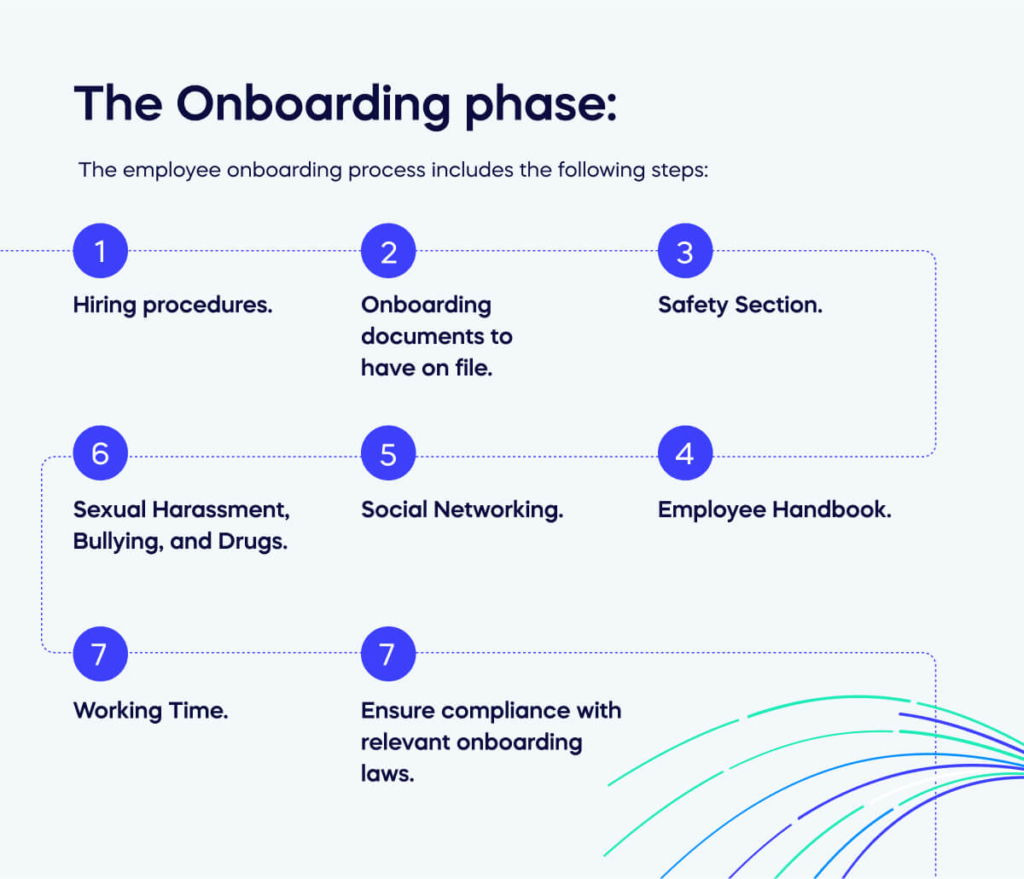
The employee onboarding process includes the following steps:
- Hiring procedures.
- Onboarding documents to have on file.
- Safety Section.
- Employee Handbook.
- Social Networking.
- Sexual Harassment, Bullying, and Drugs.
- Working Time.
- Ensure compliance with relevant onboarding laws.
Hiring Procedures
- Review offer letters.
- Review contracts.
- Orient new-hires.
Onboarding documents to have on file:
Have the following templates on file to make it easy to adjust hand them to new hires:
- Employment offer letter.
- Employemnt contract.
- Emergency contact info.
- Employee handbook.
- Organizational chart.
- Payroll and benefits.
Safety Section
- Occupational Safety and Health Acts standards in place and followed.
- Hazard communications.
- Requirement to tour workplace for safety.
- Emergency response plans.
Policies and procedures
- Review personnel handbook.
- Review company policy and procedures.
- Family and medical leave.
- Health benefits.
- Pregnancy disabilities benefits and leave.
- Other health related benefits.
- Consolidated Omnibus Budiget Reconcilliation Act.
- Drug and alcohol-free workplace specifications.
- Rehabilitation services.
- Equal pay.
- Ergonomics in the workplace.
Employee Handbook
- Equal opportunity policy.
- Dress code.
- Cell phone usage.
- Internet usage.
- Workplace relationships.
- Relevant posters in place around the workplace.
Social Networking
- Reasonable usage or prohibited usage during office hours.
- Employee posts are safeguarded.
- National Labor Law Relations Board recommends censorship.
- Discouragement of management abusing social media to check on employees.
Sexual Harassment, Bullying, and Drugs
- Annual sexual harassment training for all employees.
- Hard stance against bullying in all forms.
- Employees are able to anonymously report colleagues.
- Drug-free workplace program.
Working Time
- Must pay or meal time, travel time, overtime, remote work and other times performing work duties.
- Review policy for tracking time.
- Classificiation of employees on exemption statuses.
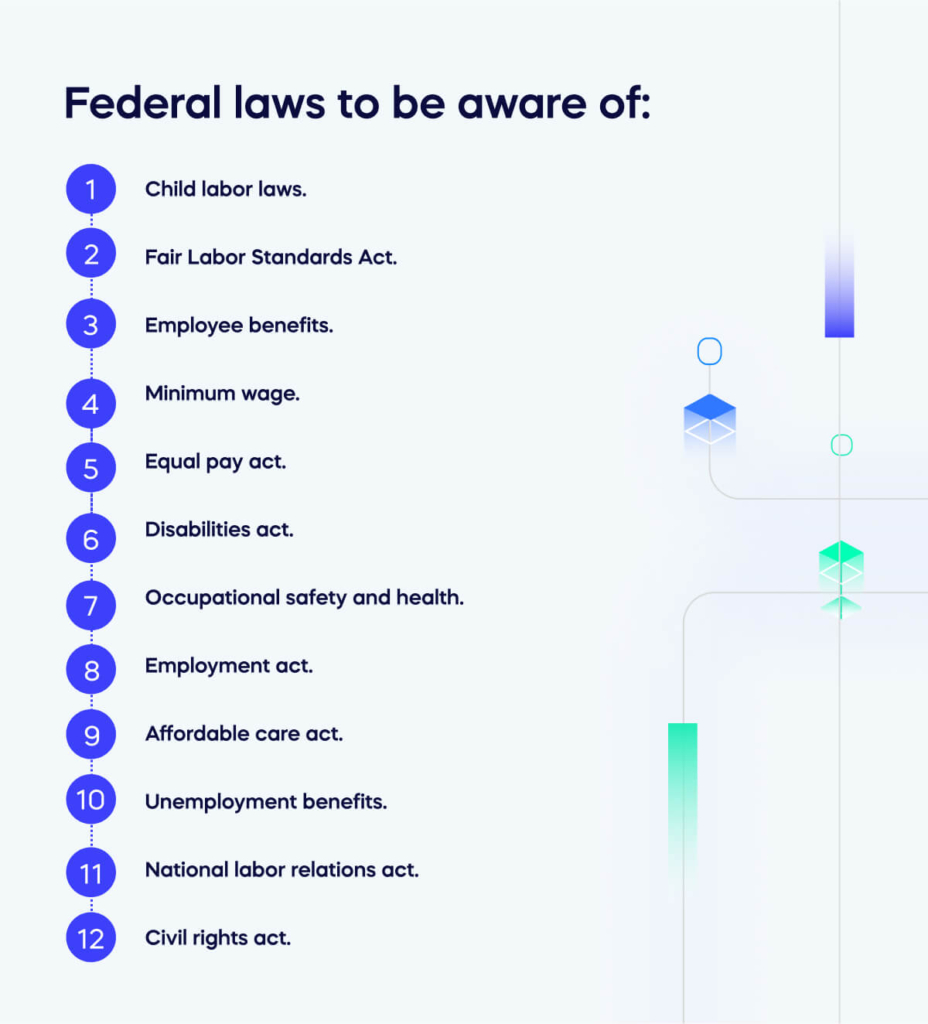
Federal laws to be aware of:
- Child labor laws.
- Fair Labor Standards Act.
- Employee benefits.
- Minimum wage.
- Equal pay act.
- Disabilities act.
- Occupational safety and health.
- Employment act.
- Affordable care act.
- Unemployment benefits.
- National labor relations act.
- Civil rights act.
Hybrid and WFH Laws
- Health & safety protocols depend on your state. Include measures for remote workers if they plan to come to the office. For instance, touchless room check-in as a safety protocol against the spread of the virus.
- The expenses you consider to be reimbursements and the employees eligible for these payments.
- Employee code of conduct whether they work from home or in the office.
- Any stipend you plan to offer and indicate that they are equally shared among in-office and remote workers.
- Desk sharing and etiquette rules for systems like hot desking.
After onboarding
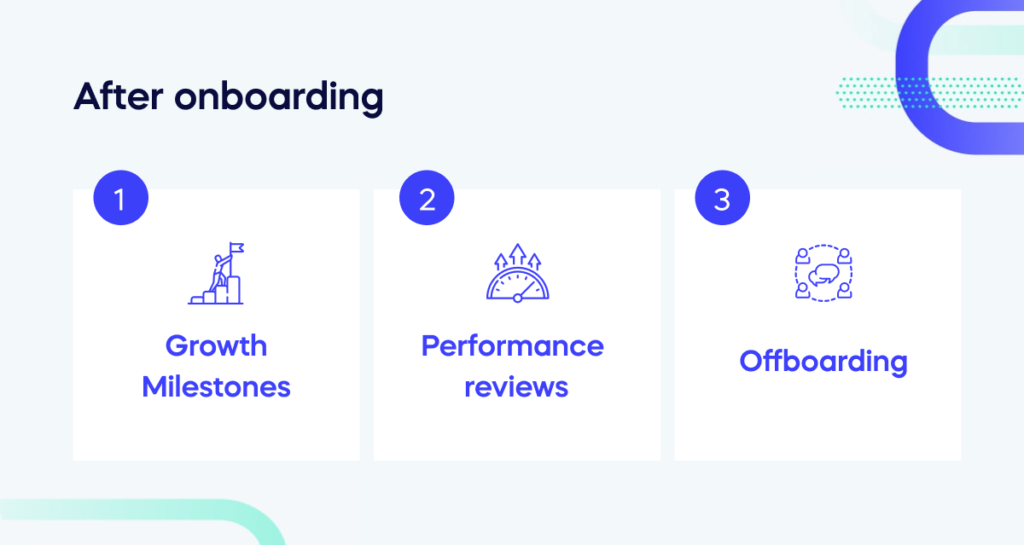
HR compliance continues after onboarding. Organizations must ensure they comply with laws relating to employee development such as growth milestones, performance reviews and offboarding.
Growth Milestones
As you expand your team, various regulations and laws come into play. Let’s explore the most critical ones together.
To begin with, the majority of FLSA regulations apply to all employers. The Wage and Hour Division from the US Department of Labor provides a comprehensive overview here: Wage and Hour Division, US Department of Labor. As an initial step for example, you must offer equal pay opportunities for both male and female employees–regardless how many people are on your payroll.
Furthermore, if your business consists of 15-19 employees, you are subject to the law that forbids discrimination based on a variety of factors like race, color, religion and sex (including pregnancy status or gender identity). The American with Disabilities Act also applies to employers within this range.
Performance reviews
- Regularly conduct performance reviews for all staff members to ensure consistent success.
- Let all employees know exactly what they need to do in their job and how they will be judged on how well they do.
- Establish methods to evaluate performance based on the tasks and standards outlined in each employee’s job description.
- Make it a priority to review and fine-tune job descriptions on an annual basis for optimal effectiveness.
- Accurately and precisely document performance records in order to effectively support personnel decisions.
- Ensure that performance reviews are conducted based on particular job-related expectations.
- Always provide truthful, accurate and comprehensive notes.
- Measure performance in terms of job roles and objectives.
- Continuously provide meaningful feedback to ensure improvement.
- Guarantee that the performance assessment system is uniform across all employees.
Offboarding
Although offboarding may seem like the lowest priority, as an employee will no longer be part of the organization, there are many good reasons to conduct a robust offboarding process.
The main three reasons are that the remaining employees perception of their organization is impacted by how departing employees are treated. Secondly, the departing employee may return if treated well at their previous organization and thirdly, equipment needs to be returned.
Therefore, it’s essential to follow the offboarding checklist, including these items:
- Thank the departing employee.
- Communicate the departure.
- Perform a knowledge transfer.
- Acquire company assets.
- Update systems access.
- Hold an exit interview.
- Review organizational records
- Inform payroll.
- Stay in touch.
Invest in a DAP to improve your HR compliance
Organizations focus too often on how HR compliance checklists can protect their organization, but any organization is made up of individuals, so it’s essential to remember that there are two reasons to implement compliance. One is to protect your organization and the second is to protect your staff, who, if trained properly will be motivated to protect their organization.
One of the best ways to implement HR compliance training is via our DAP which utilizes in-app guidance and can incorporate legal frameworks to allow HR to onboard new staff efficiently and within guidelines.
